Designs on the American Dream
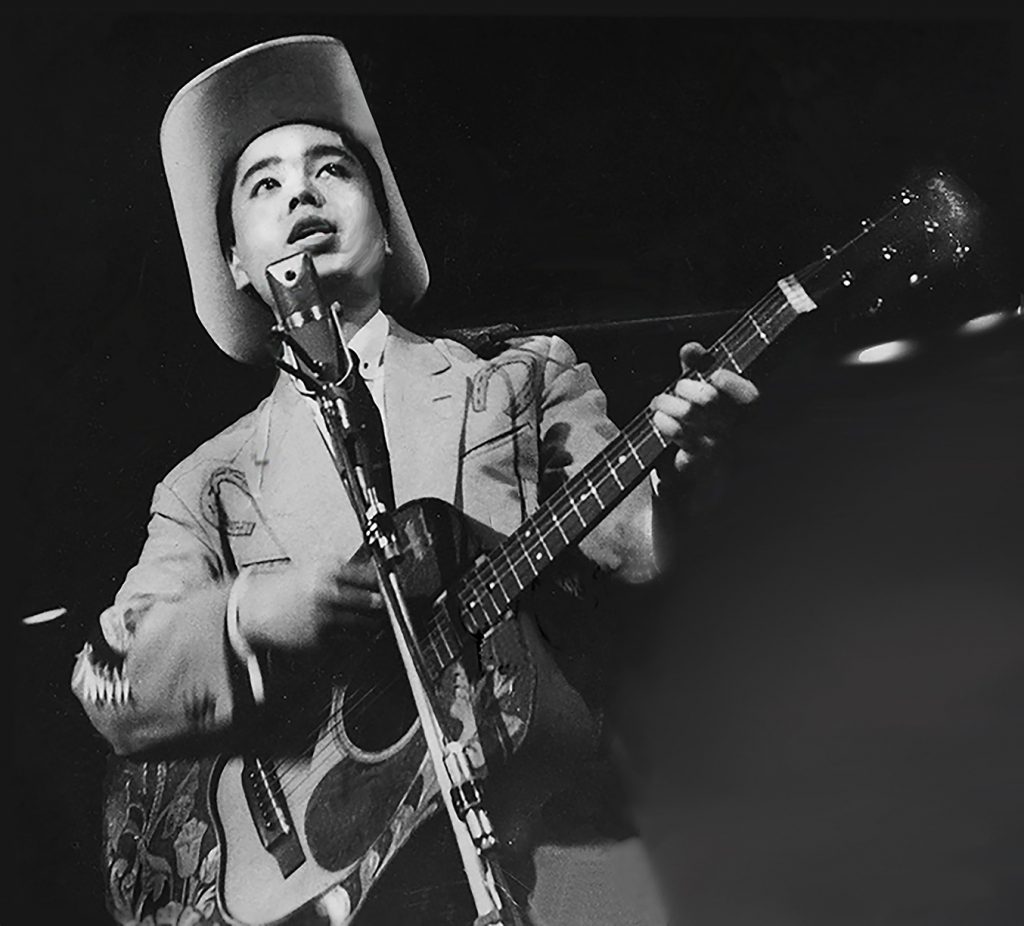
Yoshi Sekiguchi on stage in Japan, 1958 (Courtesy of Sekiguchi family.)
Like the best version of life, Yoshinobu “Yoshi” Sekiguchi understood that good art is made without boundaries. The power of imagination can lead to freedom. Open your mind and you hear songs everywhere.
In Japan during the 1960s, Mr. Sekiguchi was known as “The Japanese Hank Williams.” He had a bit country singing role in the film “A Majority of One” (1962) with Rosalind Russell playing a Jewish woman who falls for a Japanese diplomat portrayed by Alec Guinness. In the 1970s, he became a Chicago designer and art director, working with designer Art Paul at Playboy Clubs International. In 1993 Burger King sold more than 16 million Last Action Hero cups using Mr. Sekiguchi’s design.
Mr. Sekiguchi died of natural causes on March 11, surrounded by family in his Chicago home. He was 90 years old.
He was a friend of mine.
Mr. Sekiguchi was born and raised in Yokosuka, Japan (pop. 409,000), the largest harbor and ship-building facility in Japan. His father was a navy officer and all three of his brothers were pilots. Two of them died in May 1945 kamikaze operations. He also had two sisters. “I believe we were the only family who dedicated two sons to the suicide missions,” Mr. Sekiguchi told me in a 2000 interview at his home in suburban Highland Park. “If the war had lasted a few more years, I would have done the same thing. But I’m a kamikaze dropout.” He grinned and glanced at the Merle Haggard CD “Blue Jungle” sitting on a nearby fireplace. The name “Yoshi” means “good.”
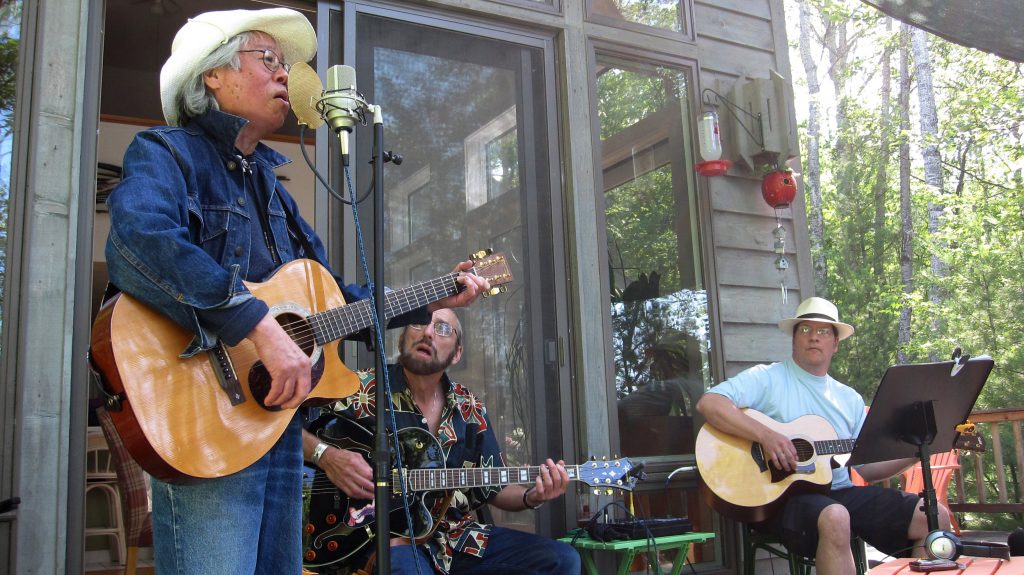
On the road again in Traverse City, Mi. with (L to R): Stan Jankowski and Rags Avery. (Courtesy of the Sekiguchi family.)
The Far East Network (FEN) first brought country music to Mr. Sekiguchi in Japan.
He was trying to learn English because Japan was fighting English-speaking countries. He figured the best way to understand the language was to listen to country music lyrics over the radio.
Mr. Sekiguchi memorized 1,500 country and folk songs. His favorites were Hank Williams’ “Your Cheatin’ Heart” and “Lovesick Blues.” When Williams died in 1953, Mr. Sekiguchi sent a condolence note to the singer’s widow. She sent Mr. Sekiguchi a photo of Hank.
The first time Mr. Sekiguchi heard a country band play at an American base in Yokosuka, he knew more songs than the musicians. Mr. Sekiguchi made his singing debut at age 17. He sang Eddy Arnold’s “The Cattle Call” to a roomful of American servicemen. The crowd cheered. They lined up ten glasses of whiskey along the stage. He had struck a chord.
Mr. Sekiguchi would say, “Yesterday’s enemy is today’s friend.”
The American GIs began calling Mr. Sekiguchi “Hank.” The effusive singer became a regular in a variety show with dancers and musicians that toured U.S. bases. They once headlined the Misawa Air Base which was near to what was then the Soviet Union. Sometimes GIs would give the performers their combat boots. No boundaries.
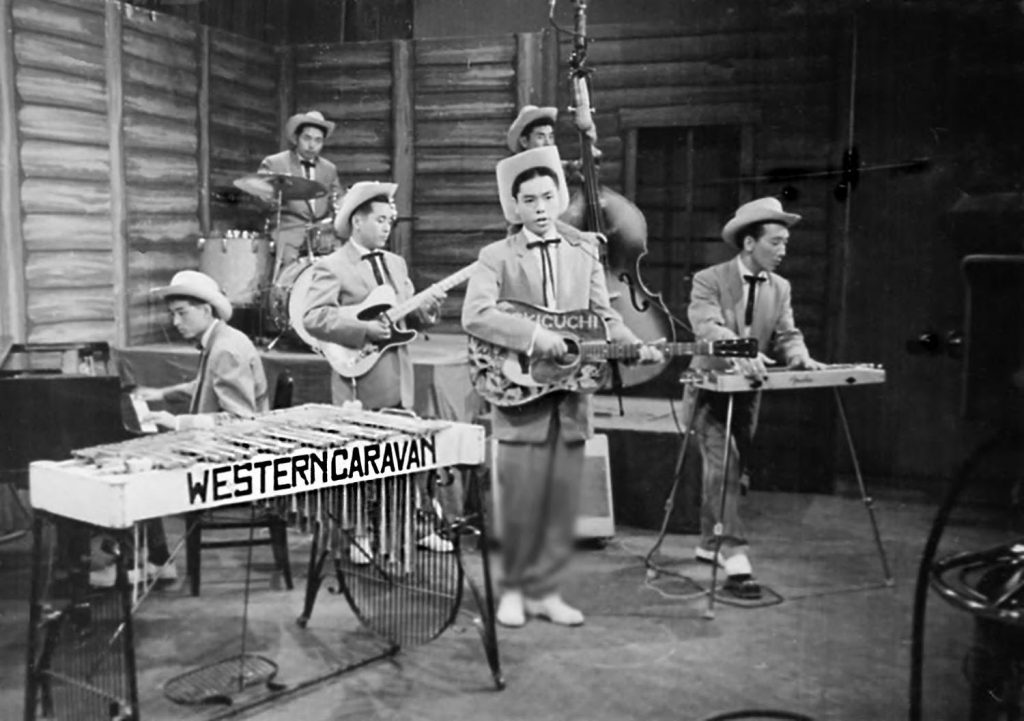
Yoshi (front, center) with his band in Fuji TV studio, 1959. (Family archives.)
Mr. Sekiguchi taught himself to play guitar during a six-month stand entertaining paratroopers in Ashiya, Kyushu. He perfected Hank Williams’ lonely yodel. His eight-minute mash-up of Williams’ “Lovesick Blues,” “Moanin’ the Blues” and “Your Cheatin’ Heart” landed in regular rotation on Honshu Hayride, the country music show on FEN. The show was hosted by Tex Howard, a former PR man for Bob Wills and his Texas Playboys. Howard took Mr. Sekiguchi under his wing. Mr. Sekiguchi later mentored Tomi Fujimaya (born 1940), the Japanese Wanda Jackson. He taught her the words to the 1935 Appalachian folk song “Mountain Dew.”
During one of his Japanese gigs, Mr. Sekiguchi met Yoshiko Nakajima. She was a model in television and print and worked as a cashier at a Tokyo cafe. She stood out in the crowd. It was all “Hey Good Lookin’ from there. The two were married in 1959. Yoshiko passed away in 2016.
Always thinking beyond barriers, they opened the Tex-Mex restaurant-steakhouse El Paso in 1961 in Tokyo’s popular Roppongi neighborhood. Mr. Sekiguchi named the restaurant after the 1959 Marty Robbins hit. The El Paso was adorned with cactus plants, Native American chiefs, and a buffalo horn above the fireplace. The ashtrays were shaped like horseshoes. Mr. Sekiguchi designed the leather-covered menu. During this time, Mr. Sekiguchi studied graphic design at Keio University in Tokyo, and shortly after that their eldest daughter Risa was born.
The El Paso became a go-to place for airline crews, tourists, and American country singers. Hank Snow ate there and Ferlin Husky brought along guitarist Sammy Pruitt, who played with Hank Williams’ Drifting Cowboys. Mr. Sekiguchi was thrilled.
When I had a book release party in October 2000 at FitzGerald’s in Berwyn, I recruited Mr. Sekiguchi to sing a couple of Hank Williams songs backed by his daughter Chika and John Rice’s fine house band. “The Japanese Hank Williams” was a willing pardner. The audience loved his effervescent nature. He seamlessly shared the stage with Jon Langford, Mavis Staples, Otis Clay, my brother Doug, Paul Cebar, Pat McLaughlin, and others.
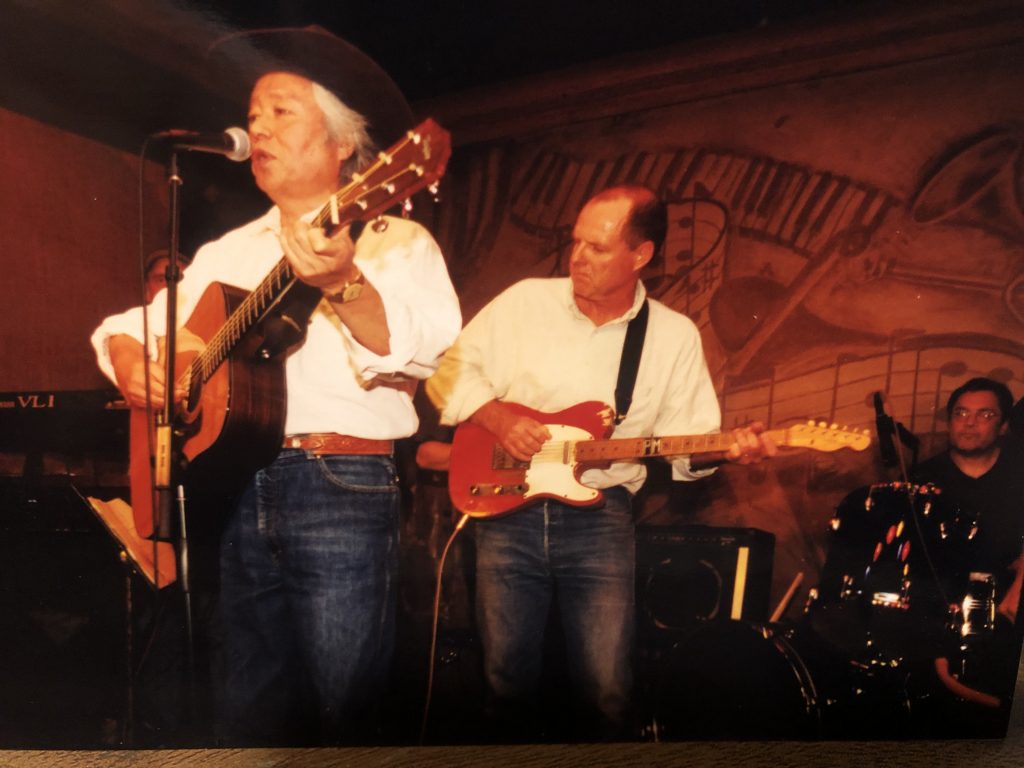
Yoshi, Nashville songwriter Pat McLaughlin and Angelo Varias on drums, Oct. 2000 at FitzGerald’s in Berwyn.
Mr. Sekiguchi connected me with Japanese musicians when I visited Tokyo in 2000 for the Chicago Cubs opening day.
We would call each other “pardner” in the notes we wrote to each other. His messages were filled with joy and hope. I saved them.
In 2017 I invited him to sing a tender version of “Jambalaya” with guitarist Dr. Tim Duggan on my WGN-AM show. He always showed up to support my projects, whether it was a book about camping across America or a documentary about music in Springfield, Mo. It thrilled me to see him and his family. Mr. Sekiguchi had a wicked sense of humor and remained curious throughout his life.
In 1987 Mr. Sekiguchi published the book “Inside Design: Where a Concept Unfolds” with the late Chicago design and film director Morton Goldsholl. He wrote of hard times after World War II ended in 1945. Mr. Sekiguchi was 14 years old. Japan didn’t have enough paper to print textbooks.
Students received paper one sheet at a time, some of which were made of thin straw. “I was especially awestruck by the printing quality on the wrappers of candies, cigarettes, chewing gum,” Mr. Sekiguchi wrote. “They had many vivid colors, even silver and gold. My eyes had been accustomed to only black and white printing for so long. Although I didn’t realize it at the time, my hope to go to America was embedded in my heart.”
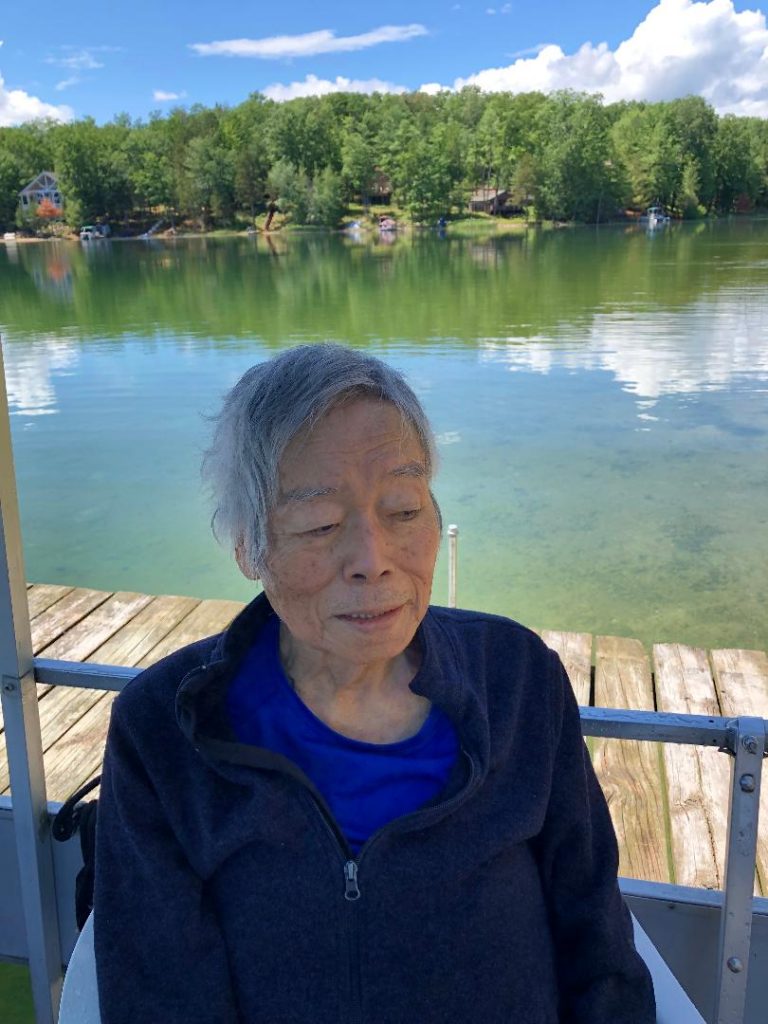
Yoshi Sekiguchi by his favorite Michigan lake; June 2021 (Family photo.)
Mr. Sekiguchi came to the American kaleidoscope in 1964 when he bought a one-way ticket on the President Cleveland ocean liner from Yokohama to San Francisco. He then purchased a month-long Greyhound bus pass to explore the country.
Back in Japan, Mr. Sekiguchi had seen an advertisement in the Horizons travel magazine for the Wild Horse dude ranch in Tucson, Az and he searched for that sunrise.
He spent a few months at the dude ranch where he sang country songs, although the Wild Horse introduced him as “The Japanese Pat Boone.” Mr. Sekiguchi also taught some karate on the side.
Many of the Wild Horse guests were from Chicago which is how he learned about the city’s job opportunities. He moved to Chicago in the summer of 1964 and in April 1965 he brought his family over from Japan. They moved into a two-bedroom apartment in Lincoln Park, near the lake. In 1970 they settled in Highland Park where the family lived until 2014……………
Here is a beautiful retrospective assembled by Yoshi’s family.
…………Mr. Sekiguchi’s first job in Chicago was at the Restaurants and Institutions trade magazine. In 1971 he became art director at VIP, the magazine for Playboy Clubs International. Mr. Sekiguchi was enchanted with the magazine’s typography and graphic design. At that point, the club’s membership was about a million, with 27 clubs worldwide including hotels and casinos.
In 2000 Playboy magazine’s art director Art Paul (1925-2018) told me, “Yoshi has a wonderful sense of design. Every year it gets better. Every once in a while he would sing at a party at his house. The first time I saw him do any professional work was at one of those western clubs outside of Chicago. He was all in his cowboy garb and doing wonderful stuff.” Mr. Sekiguchi took the stage for his surprise 60th birthday party at the old RR Ranch in west suburban Franklin Park.
When VIP folded in 1975, Mr. Sekiguchi opened his own studio “Rising Sun Design.” In 1987 he worked with editor Rich Christianson at the trade magazine Wood & Wood Products in Lincolnshire. They collaborated on magazine covers, supplements and redesigns.
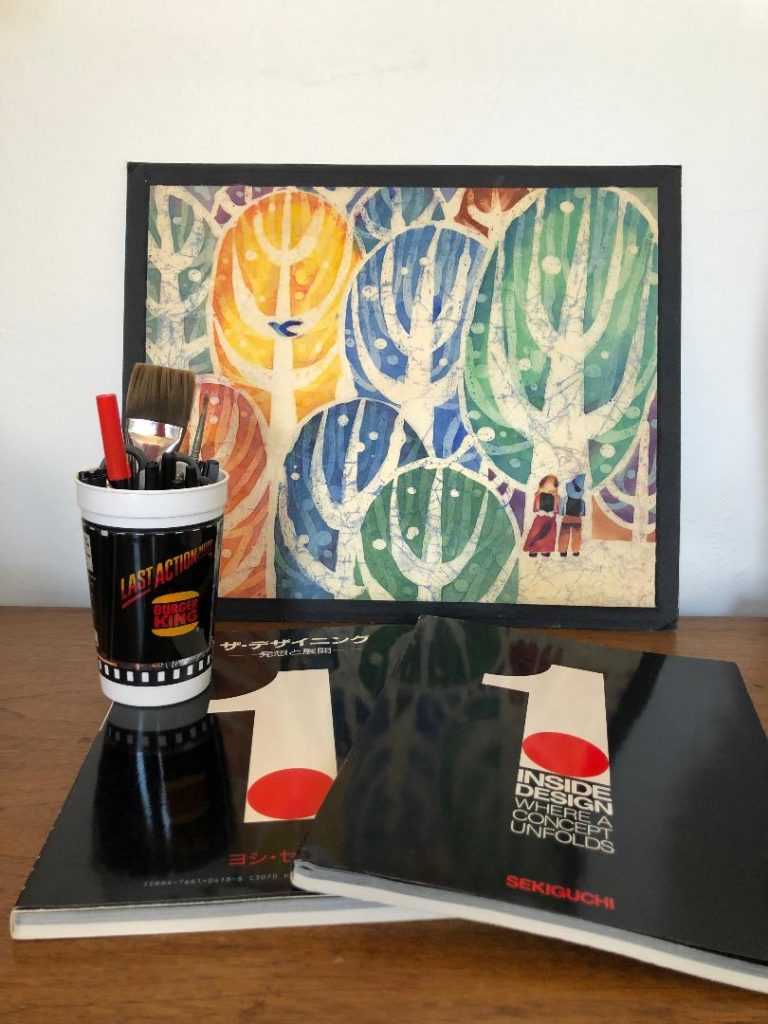
From left, Yoshi’s Last Action Hero Cup with tools of his trade, Hansel and Gretel batik, and his Inside Design books in English and Japanese. (Courtesy of Sekiguchi family.)
“He was extremely resourceful, especially in the days before digital tools were available,” Christianson said on Sunday. “I can’t tell you how many times Yoshi came to my office when deadlines were looming and we still needed a cover. But I can say that he never left without having an idea of at least an inspiration of what he might create. He was a ‘Design God.’
“Even more so, I am glad I got to know and befriend a man who lived such an amazing life and yet was so down to earth and good-natured.”
And, on Sunday his daughter, Risa reflected, “My Dad accomplished so much, but his dreams were even bigger. He wanted to design a swimming pool where you would swim with the current against you. That hadn’t been invented. They were dreams much bigger than he could achieve, even though he achieved so much. Sometimes he was disappointed he didn’t reach more of his dreams or have them be more lucrative, honestly.
“But we loved it. He was always so much fun as a Dad. He took us on trips and made sure we went to museums and had fine food. He wanted us to learn about culture. It was amazing.” His middle daughter Chika once had her own pop-rock band. She sampled her father singing Hank Williams’ 1955 ballad “Please Don’t Let Me Love You” in a secret track on her Little Ship Head CD.

Yoshi at Daisen-in, a sub-temple in Kyoto, circa 2015. From left: Ozeki Soen, head priest of Daisen-in, Kiyumi Daniel, Yoshi, Tom Daniel, Yoshiko Sekiguchi, Risa and Chika Sekiguchi. (Provided photo.)
While perusing his beautiful “Inside Design” book during my 2020 visit to his split-level home, Mr. Sekiguchi suddenly paid tribute to our mutual hero Merle Haggard. The summer light covered the family’s spacious living room like a magic carpet. He quoted Haggard’s song “Big City,” reading aloud: “Been working every day/Since I was 20/Haven’t got a thing to show/For anything I’ve done.”
Mr. Sekiguchi smiled and said, “I am glad to say, I now have something to show.”
In addition to being an award-winning graphic designer, Mr. Sekiguchi was also an inventor, securing patents and licensing technology for clients including Burger King, Disney, and Scholastic.
Mr. Sekiguchi was predeceased by his wife Yoshiko (Nakajima). He is survived by daughters Risa (Kirk Vuillemot), Chika –named after Chicago–(Tom Daniel), Juri (Tom Mc Campbell), and grandchildren Ellie, Aidan, and Kiyumi. In lieu of flowers, please send donations to the Hank Williams Museum in Montgomery, Al. in memory of Yoshinobu Sekiguchi.
A celebration of his remarkable life will be held this summer.
Happy trails, pardner.
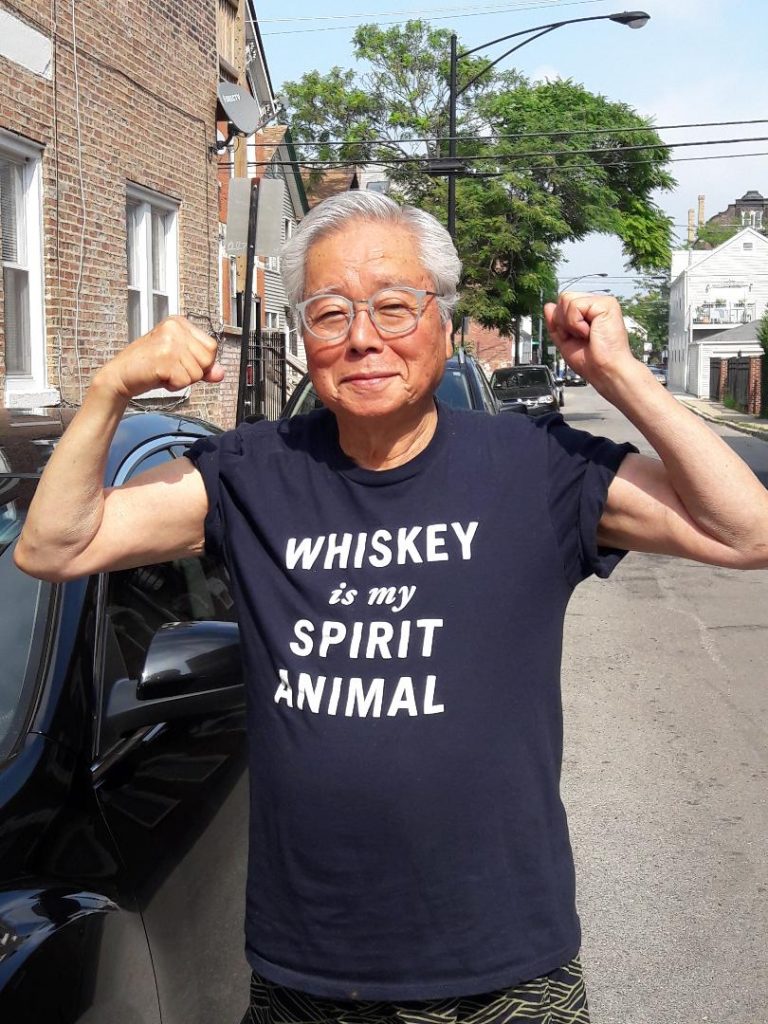



Lovely tribute, Dave! Do I remember him singing at one of the Buck Owens birthday tributes?
Thank you Monica! Yes, I believe he did. Take care, Dave
What a wonderful tribute to Yoshi. Thank you Dave. ‘Life is not measured by the number of breaths we take, but rather by the number of times our breath is taken away. ‘Beautiful!
Thank you, Pat, for reading and the kind remembrance of Yoshi.
Thank you for this wonderful, heartfelt tribute. Our family will cherish this post, and your previous articles, for all of time. Our father might have been charming and entertaining around friends and strangers, but he was a stoic, traditional Japanese father to us. As such, he remained somewhat of a mystery to us for much of the time. We are grateful he found a true friend, or “pardner” in you, Dave.
Thank you, Risa. It has been such a precious gift to know Yoshi and your family. Going to play my “Yoshi Sings Hank and Marty” CD tonight!
Few of us managed to summon the courage to live a creative life like Yoshi did. His gift to us was his innovative ideas and laughter which brought warmth to our hearts in surprising ways. We in turn loved and admired him for his enthusiasm for life. In addition, he gave the world three beautiful daughters who continue his creative impulses through their families, art, and hearts. They have continued his legacy of making life delightful. The ripples of his presence will expand throughout the universe for many years to come. We will miss him.
I would urge everyone who knew and loved Yoshi to remember his songs, to reflect on your memories of him, and to talk to him. He needs our understanding and insight to digest his very full life. Yoshi is only a thought away, as are all of our ancestors, who are still very much alive within us.
Thank You, Tom. A most wonderful proposal to share, Take care, Dave
What a heartfelt and awesome tribute. Having grown up with his kids, it’s fascinating to fill in the story of the bits and pieces I remember. Thank you!
Thank you Erica for reading and writing this. Dave
Great tribute, Dave. Like you, I feel blessed to have known Yoshi. I have fond memories of him, not least of which is the time we spent chatting with you in your studio and playing Hank songs. Happy trails to Yoshi.
Tim
Thanks, Tim, I listened to our segment over the weekend. Great stuff and great memories. Dave
Thanks crafting auch a magnificent tribute to Yoshi’s life. I thought I knew him well, but learned many new things in reading your piece.
Thank you Rich for giving us insight into Yoshi and thanks for writing.